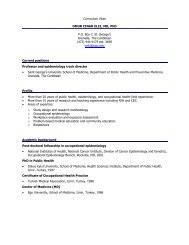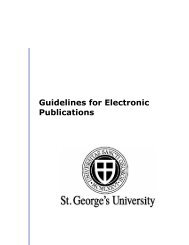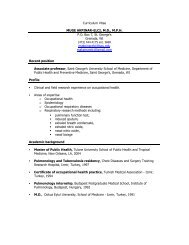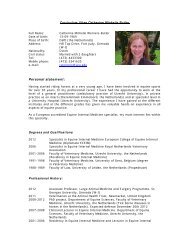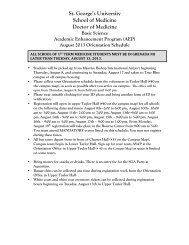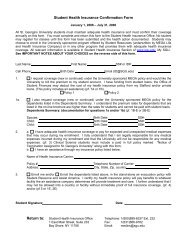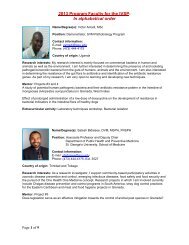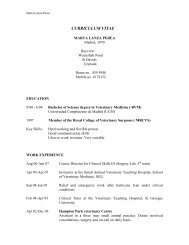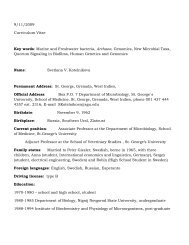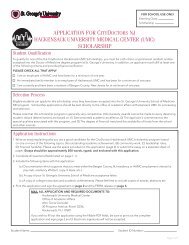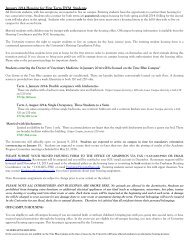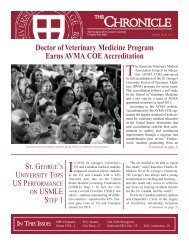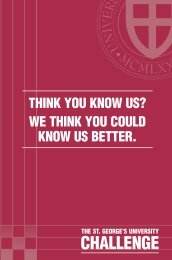SCHOOL OF 2012-2013 - St. George's University
SCHOOL OF 2012-2013 - St. George's University
SCHOOL OF 2012-2013 - St. George's University
You also want an ePaper? Increase the reach of your titles
YUMPU automatically turns print PDFs into web optimized ePapers that Google loves.
School of Medicine<br />
Course Descriptions<br />
of commonly used psychotropic drugs. They will become<br />
familiar with the major psychiatric syndromes in children<br />
and adolescents, as well as with the effects on the child/<br />
adolescent/family of the life-disrupting syndromes of child<br />
abuse and substance abuse. <strong>St</strong>udents will learn detection<br />
and treatment of these syndromes, as well as how to evaluate<br />
and manage psychiatric emergencies. The goal is for<br />
students to feel more comfortable with psychiatric patients,<br />
and, ultimately, possess an understanding of biological,<br />
psychological, and social determinant behavior. <strong>St</strong>udents<br />
must fully work up at least one patient a week. The history<br />
and mental status examination are presented to the preceptor<br />
and the case is discussed. <strong>St</strong>udents must follow each patient’s<br />
progress throughout the duration of the rotation. <strong>St</strong>udents<br />
must attend ward rounds and outpatient sessions.<br />
Attendance will be expected at case conferences and<br />
seminars. Special experiences are recommended. These<br />
include attendance at Alcoholics Anonymous meetings<br />
and visits to local mental health facilities, county, and/or<br />
state hospitals, addiction programs, and any other special<br />
programs in the vicinity of the hospital. Observation and<br />
participation in group therapy, pre-discharge, and postdischarge<br />
group management are required.<br />
Pediatrics<br />
Phyllis Weiner, MD, Chair<br />
The goal of the rotation in pediatrics is to allow students to<br />
acquire the basic knowledge of the normal physical, mental,<br />
and emotional development of children. <strong>St</strong>udents learn<br />
how this development is influenced by medical, social, and<br />
educational factors, as well as understand the common<br />
disorders and diseases of childhood, especially their<br />
diagnosis, management, and prevention. <strong>St</strong>udents will be<br />
taught to be aware of the special needs of the newborn, the<br />
handicapped child, and the adolescent. An integral part<br />
of the rotation is the opportunity to acquire the necessary<br />
skills of taking a pediatric history, to examine children of all<br />
ages, and to acquire experience in evaluating the essential<br />
clinical information so that a coherent plan of management<br />
can be formulated and explained to the parents and, as<br />
appropriate, to the child. <strong>St</strong>udents learn to appreciate the<br />
value of a confident but sympathetic approach to the child<br />
and the family while recognizing and accepting the limits<br />
of that unit’s expectations and understanding. <strong>St</strong>udent<br />
reading is structured during the six weeks so that they<br />
first become acquainted with the normal child and then<br />
learn history taking and physical examination, reactions<br />
of children to illness and hospitalization, the principles of<br />
infant feeding, and fluid and drug therapy.<br />
Emergency Medicine<br />
Theodore Gaeta, DO, MPH, Chair<br />
The goal of the rotation in emergency medicine is to<br />
teach medical students the necessary skills to take care<br />
of patients with a wide variety of undifferentiated urgent<br />
and emergent conditions. <strong>St</strong>udents learn how to approach<br />
patients with common and potentially life-threatening<br />
complaints (such as chest pain, headache, abdominal pain,<br />
and many others). Emphasis is placed on teaching how<br />
to develop a working differential diagnosis and how to<br />
appropriately narrow it. During the rotation, students have<br />
the opportunity to gain proficiency in rapidly collecting<br />
data and performing focused physical examinations<br />
appropriate for the acutely or emergently ill patient.<br />
<strong>St</strong>udents function as an effective and essential part of<br />
the emergency medical team in the patient assessment,<br />
stabilization, and management of a variety of acute medical<br />
76 | <strong>St</strong>. George’s <strong>University</strong>



